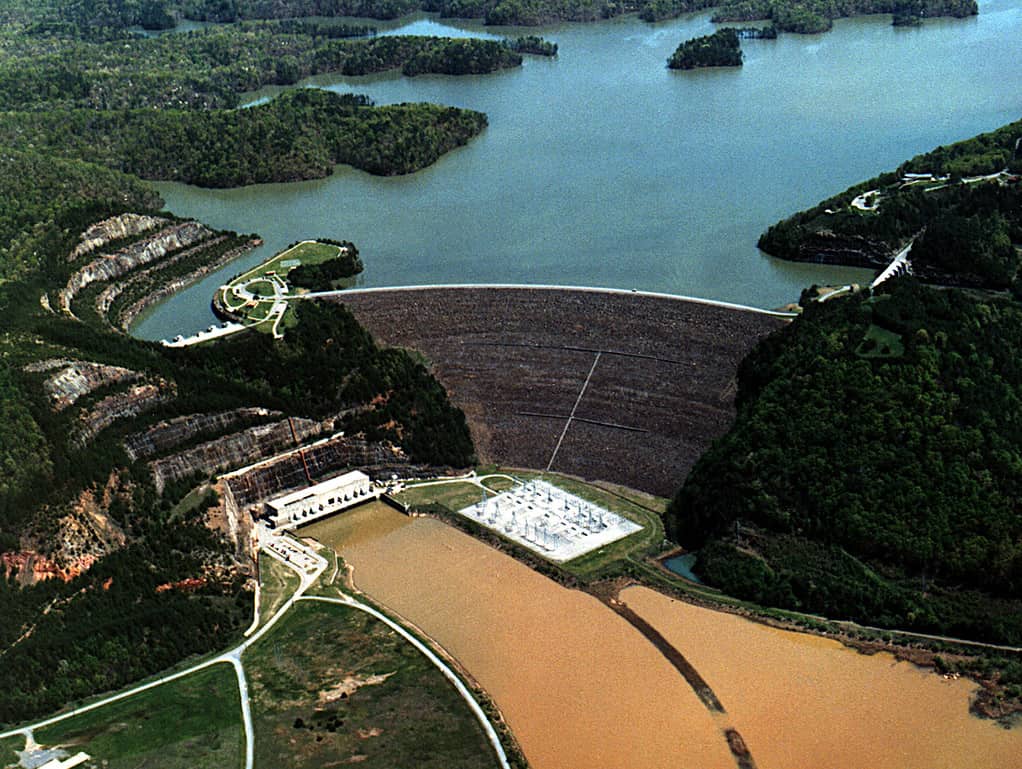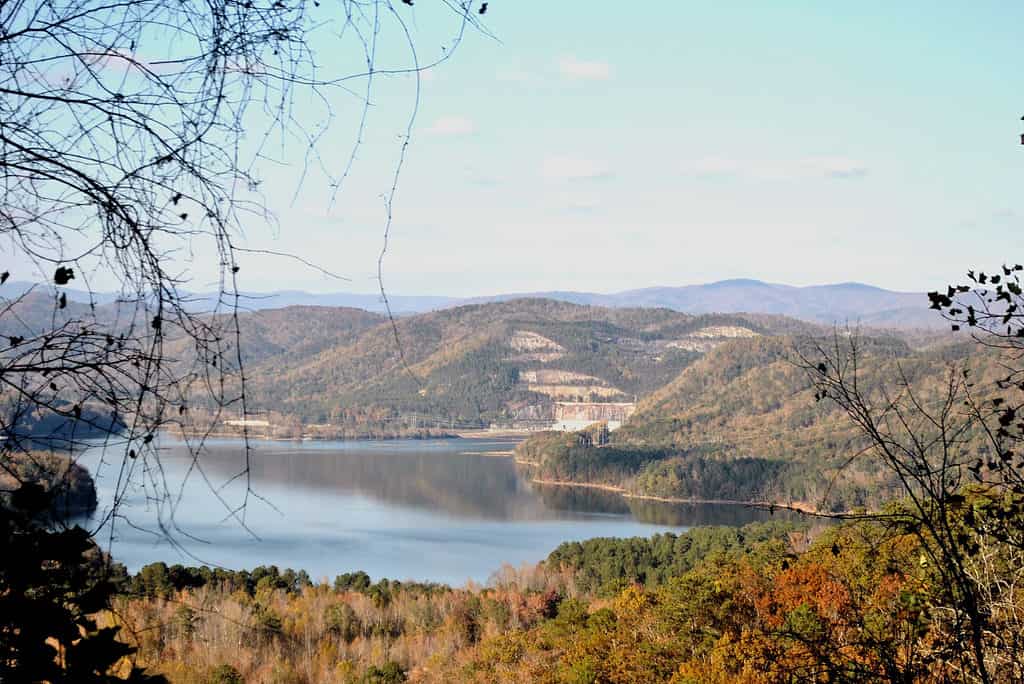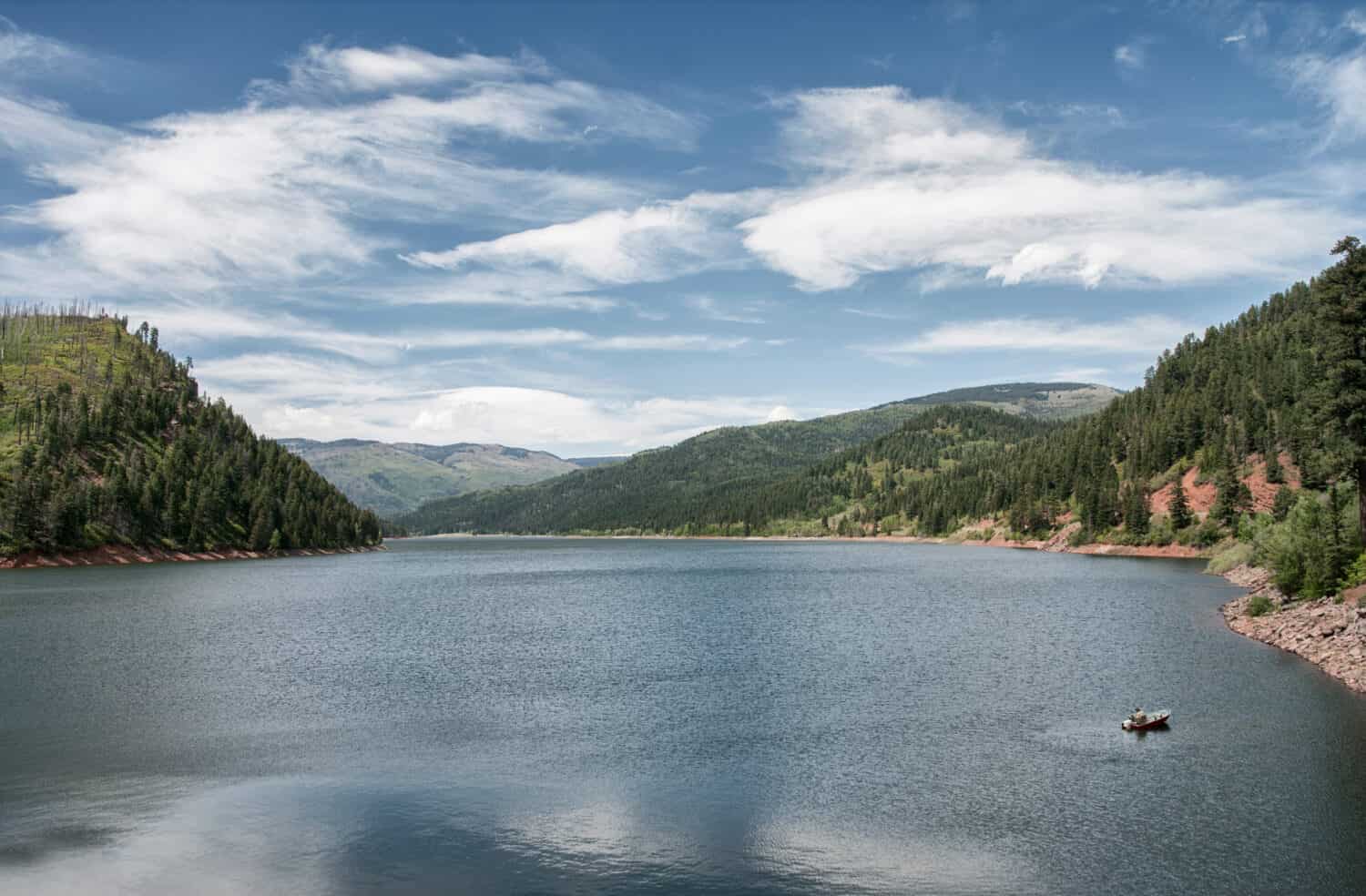Key Points:
- Carters Dam, the largest dam in Georgia, was completed in 1977.
- Its primary purpose was flood control for the river valley below. It was also built for hydroelectric power generation and the hydro plant’s four turbines can generate 500 megawatts.
- The dam construction created Carters Lake, the deepest lake in Georgia and 3,200 acres in size.
In the U.S., numerous dams dot the landscape. These artificial structures affect the flow of rivers. Most states that build dams do so to have water reservoirs for industrial or household use.
Most of the water in dams is for electricity production and irrigation. And this is the case for the largest dam in Georgia. Let’s learn more about this massive 445-foot structure!

What Is the Largest Dam in Georgia?
The largest dam in Georgia is Carters Dam. It stands 445 feet tall and is on the Coosawatee River. The dam sits exactly 26.8 miles above the river and has a drainage area that’s 376 square miles.
As a result of building this dam, Georgia got its deepest lake, Carters Lake. There is a diversion tunnel on Carters Dam measuring 2,407 feet with a horse-shaped design. The diversion tunnel has a 23 feet width.
The area around the Carters Dam has always had significance in the U.S. Native Americans named it “The Great Valley” and remnants of their presence in the area still exist to date.

Carters Dam impounds Carters Lake in the mountains of northwestern Georgia.
©Adrien Lamarre, U.S. Army Corps of Engineers / Public domain – Original / License
Where Is Carters Dam Located on a Map?
Carters Dam is in Murray County, west of Ellijay and south of Chatsworth. It is around 77 miles’ drive north of downtown Atlanta.
Why Was Carters Dam Built?
The U.S. Army Corps of Engineers was responsible for constructing Carters Dam, with its primary purpose flood control for the river valley below.
It was also built for hydroelectric power generation. Carters Dam has a regulation reservoir at its base. It serves as a pumped storage lower reservoir. Since this is a hydro plant, it’s worth noting that it can generate 500 megawatts. The plant has four turbines for this purpose.
When Was the Carters Dam Constructed?
In 1977, the U.S. Army Corp of Engineers completed the construction of Carters Dam after 10 years. The dam got its name from a wealthy Georgian named Farish Carter, who lived in the area in the 1800s.
What Would Happen If Carters Dam Ever Broke?
The main purpose of the largest dam in Georgia has been to control flooding in the area. This reservoir holds lots of water. If Carters Dam ever broke, the towns beneath it would feel the full effect of the water.
It’s safe to say the sheer force of the water would wipe out the towns. In addition, areas that rely on the hydro plant would go without electricity.
The dam breaking would require farmers in the area that rely on the water to find another source. Also, animals that live near the dam would die. Thankfully, there’s little to no chance of such a disaster happening.
Wildlife Around the Largest Dam in Georgia

The artificial structure is the sole reason that Georgia has Carters Lake, a significant part of the area’s ecosystem.
©Brittany Hollier/Shutterstock.com
The construction of Carters Dam resulted in Carters Lake, a significant part of the area’s ecosystem, which covers 3,200 acres. The largest dam in Georgia boasts several types of fish. Its surrounds are home to different animals and birds. Let’s take a look at a few species that inhabit the area.
Red Fox
The red fox is one of the most cunning and wise animals you can find. And it’s been revered for its wiliness in different cultures worldwide. Given its wide distribution, there are 40 different subspecies of the red fox.
An adult red fox weighs 10 to 15 pounds and can be 26 to 42 inches long. It comes from the same taxonomical family as the wolf. However, it doesn’t form packs. Instead, you might encounter an adult male or two females in a specific territory.
Mostly, red foxes are nocturnal animals, meaning they hunt when the sun goes down. They use their intelligence when hunting and communicating with each other. At night, the red fox roams its territory searching for rabbits, rodents, fish, eggs, fruits, and vegetables.
Black Bear
Black bears are present in the area around Carters Dam in Georgia. These magnificent beasts prefer inhabiting forested areas. They are solitary animals and only come together when mating. The mother will stay with her young until they’re old enough to venture off independently.
In the wild, the black bear is always roaming around for food. They must put on enough weight to see them through winter when they hibernate. As a result, the bear eats almost anything from small animals to large animals, wild berries, plants, and fruits.
Mating season takes place during summer. The bears come together for only a moment, then head off to search for food. The gestation period of the black bear is seven months, and the female often gives birth to one to five cubs.
White-Tailed Deer
There are numerous species of deer worldwide. One of them is the white-tailed deer. It’s a big deer species with a changing coat. The deer has a deep brown winter coat and a tan or reddish-brown coat in spring and summer.
An adult white-tailed deer can stand 1.7 to 3.9 feet tall. Males grow antlers in spring and summer. However, these fall off in fall and winter to regrow in the coming year.
Deer are always on alert in the wild since they have many predators. White-tailed deer prefer the safety of a herd and areas with ample coverage.
Once a white-tailed deer is two years old, it’s time to mate. They get pregnant in the fall, and gestation lasts 205 days. Mom gives birth to a fawn during spring, during which there is ample green grass.
Beaver
Watching the beaver create a dam is always fascinating. In the wild, this semi-aquatic rodent significantly impacts the landscape. Often, the dam has numerous benefits, and it’s always wonderful to have beavers around.
The North American beaver has a stout body. It includes a strong neck, short, rounded ears, an oversized head, flat tail, webbed feet, and nimble hands. It has a waterproof coat that’s beneficial given its semi-aquatic lifestyle.
In the wild, the beaver is always at work constructing its dam. The purpose is to ensure the dam is ready during summer and early fall. Regarding diet, the beaver is an herbivore that forages for plants that it stores in the dam.
Beavers practice monogamy and will remain faithful to their partner. They mate every year from January to March. The gestation period is three months, after which the mom gives birth to one to four kits.
Opossum
The only marsupial you’ll likely encounter in the U.S. is the opossum. These are savvy scavengers that relish going through trash and garbage cans.
Opossums in the wild aren’t too large. Instead, they resemble a house cat in size and can weigh between eight to 13 pounds. An adult opossum has 50 teeth that are useful when scavenging for food.
These nomadic, solitary marsupials move slowly and are more active at night. They don’t hibernate and will be on the move in winter, searching for food. Scavenging causes opossums to clash with humans as they ravage through trash cans at night.
Regarding reproduction, female opossums can have multiple litters in a year. Mating starts in mid-winter and continues to mid-summer. Once the female gives birth, she remains with the little ones until they’re three months old.
Wild Turkey
Wild turkey, or eastern turkey, inhabit many forested areas in North America. Mostly, these large birds prefer areas with hardwood forests with clearings for foraging.
While some folks are only familiar with domestic turkeys, wild ones still thrive. These are nonmigratory birds. Turkeys depend on different food sources such as nuts, insects, plants, grasses, roots, and fruits.
While some animals are monogamous, the wild turkey is polygamous. A male turkey mates with multiple hens. Each hen can lay 10 to 14 eggs and incubates them for 28 days. Poults that hatch from the eggs stay with their mom for four months.
Spotted Bass
The spotted bass is one of the most popular fish species in the U.S. Often, folks who enjoy recreational fishing aim to catch spotted bass. However, it’s easily mistaken for the smallmouth bass and the largemouth bass.
Often, the spotted bass is a medium-sized fish with a laterally compressed body. The backs of the fish have a pale green to light-brown appearance. There are also black spots on the sides, and they have deep red eyes.
Turtles, snakes, and alligators are some of the spotted bass’ top predators in the wild.
Spotted bass is fully mature by age one. However, they wait until age four to reproduce. Breeding season for the spotted bass starts in spring when the temperatures rise. If temperatures rise earlier in the year, then mating begins early.
Female spotted bass can lay anywhere from 1,100 to 47,000 eggs. The males will clear a gravel bed and then entice the female to lay her eggs on that spot. After that, he stands guard until the eggs hatch after a few weeks.
Smallmouth Bass
Any person who ventures into freshwaters that have fish will most likely come across the smallmouth bass. It’s native to many lakes and rivers across North America.
The smallmouth bass differs from the largemouth bass. Its mouth is much smaller and can manifest a wide range of colors. The fish can be dark brown to bronze and olive to light green. If the waters are clear, the smallmouth bass will be darker, and vice versa.

Smallmouth bass is common in Carters Dam.
©iStock.com/LaSalle-Photo
Often, the smallmouth bass will eat anything it can overpower. It’s an opportunistic feeder that goes after any available prey. However, the small mouth means it has to target smaller fish and marine life.
Regarding reproduction, once a pair of smallmouth bass come together, they mate for life. Mating takes place from May to June when the water is warmer.
Males are responsible for building nests using rocks, gravel, and sand. A female will then lay up to 10,000 eggs that start to hatch in four to 11 days.
Bald Eagle
The mighty bald eagle is one of the most famous in the U.S. It’s a symbol of strength and power. One crucial fact is the bald eagle is a protected species. It was once on the brink of extinction, but today thrives thanks to extensive conservation efforts.
The bald eagle inhabits North America, preferring forested areas near bodies of water. Males pair up with females, constructing a nest in the canopy. The nest comprises woven sticks lined with moss or lichen.
Meat is the main food source for the bald eagle. It’s a predatory bird that hunts small prey and fish. An adult with a wide wingspan can grow between 28 to 38 inches tall. Those to the north of Canada and northern parts of the U.S. tend to migrate south in search of warmer climates.
Regarding breeding, a pair remains together and mates until one partner dies. After mating, the female lays one to three eggs once a year. Mom and dad will take turns incubating the eggs and hunting until they hatch.
Thank you for reading! Have some feedback for us? Contact the AZ Animals editorial team.








